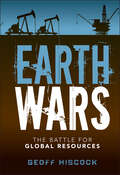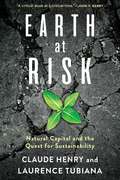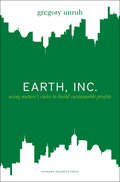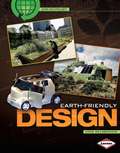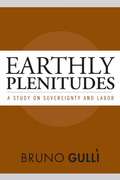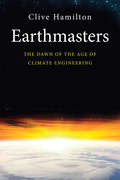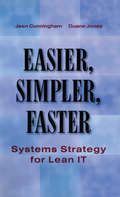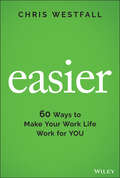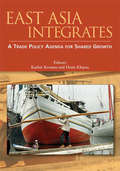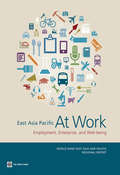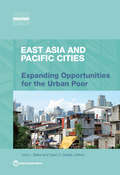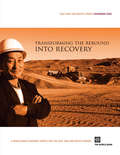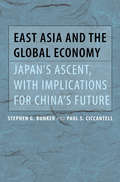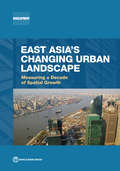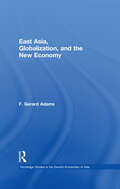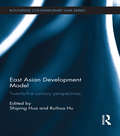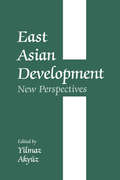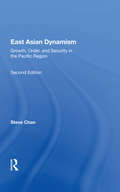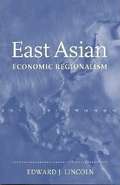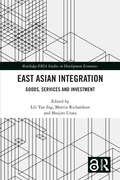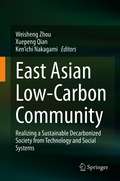- Table View
- List View
Earth Wars
by Geoff HiscockA fascinating insight into the global battle for our energy futureThe global competition for scarce natural resources that pits the West against the super-hot economies of China and India, plus a clutch of other contenders including Russia, Brazil, and Indonesia, has become one of the biggest issues facing the world today. Whether it is the rare metal lithium found in salt pans in the Andes, gas from the Caspian Sea, oil off the coast of Brazil, coal from Africa's Zambezi River, or uranium from Kazakhstan, China and India are desperate to ensure the security of their future energy supplies. The same goes for food and water, as contamination and over-use take their toll, the need to provide continued access for the next generation and beyond has increased exponentially. In Earth Wars: The Battle for Global Resources, international business journalist Geoff Hiscock explores the problems, potential solutions, and inevitable tensions in this ongoing scramble for finite natural resources.Going beyond "big power" politics to explore resource ownership and the use of innovative technology to get the most out of them, the book takes a forward-looking approach to this pressing issue. Written in clear, jargon-free language, it tells the global resources story in a fresh and engaging way that anyone can understand.Includes insightful, up-to-the-minute coverage of the most pressing debates over resource allocationsDiscusses the major Chinese and Indian businesses that are just becoming known to those in the West (Sinopec, CNOOC, CNPC, Indian Oil, ONGC, Reliance, Coal India, SAIL, and many others)Presents resource- and region-specific chapters to help readers view the pertinent issues from multiple anglesAs the economies of China and India grow to challenge those of the West, the battle over natural resources will continue to heat up. Earth Wars looks at this very real problem in-depth, presenting a definitive look at one of the greatest challenges of our time.
Earth at Risk: Natural Capital and the Quest for Sustainability
by Laurence Tubiana Claude HenryWe are squandering our planet’s natural capital—its biodiversity, water and soil, and climate stability—at a blistering pace. Major changes must be made to steer our planet and people away from our current, doomed course. Though technology has been one of the drivers of the current trend of unsustainable development, it is also one of the essential tools for remedying it. Earth at Risk maps out the necessary transition to sustainability, detailing the innovations in science and technology, along with law, institutional design, and economics, that can and must be put to use to avert environmental catastrophe.Claude Henry and Laurence Tubiana begin with a measure of the costs of ecological damage—the erosion of biodiversity; air, water, and soil pollution; and the wide-reaching effects of climate change—and then consider the solutions that are either now available or close on the horizon and that may lead to a more sustainable global trajectory. What community-driven or market-based tools can be used to promote sustainable development? How can renewable energy and energy storage advances help us decrease our use of fossil fuels? How can we substitute agroecology for the damaging chemical methods of industrialized agriculture? Is international agreement on climate goals possible? Building on the experience of the most significant climate negotiation of the decade, Earth at Risk shows what a world organized along the principles of sustainability could look like, no matter how optimistic it may seem at the present moment. Though formidable obstacles remain to the realization of this significant transition, Henry and Tubiana present the case for collective initiatives and change that build momentum for implementation and action.
Earth, Inc.
by Gregory UnruhHaving trouble reconciling your desire to do good by the environment while also moving your company forward? In Earth, Inc., Gregory Unruh shows you how to embed sustainability into everything your company does - profitably. Providing prescriptive steps that will inform your business decisions, Unruh will help you launch your company into eco-minded practices. His five Biosphere Rules apply the laws of nature as a guide for efficient and innovative business operations. Instead of a linear value chain, Unruh offers a cyclical value chain - a chain that offers both sustainability and profitability, for now and for the future.
Earth-Friendly Design (Saving Our Living Earth)
by Anne WelsbacherDesigners create all products, from computers and cell phones to cars and buildings, to meet the needs and desires of buyers. But did you realize that each stage in the life of a manufactured product involves processes that can damage Earth's land, air, water, and the health of living things? Earth-friendly design can help us make our planet healthier. We must join together in this quest to make, move, use, reuse, and dispose of things in Earth-friendly ways. With engaging text and eye-catching images, plus a special Going Green section, this book tells you all about Earth-friendly design and what you can do to promote it.
Earthly Necessities: Economic Lives In Early Modern Britain (The\new Economic History Of Britain Ser.)
by Keith WrightsonThis lucid and elegantly written book seeks to redefine the economic history of early modern Britain for a new generation of readers. Combining the research of economic historians with the insights provided by recent advances in social and cultural history, Keith Wrightson describes the basic institutions and relationships of economic life, traces the processes of change, and examines how these changes affected men, women, and children at all social levels. Wrightson reemphasizes the significance of the period as a turning point in British economic development, one that included the creation of an integrated market economy, the expansion of capitalist organization and enterprise, and reconfigurations of economic power. He shows how economic practices and priorities were embedded in social relations and how shifts in attitudes, values, and understandings played an essential part in the emergence of a market society. And he compares and contrasts the distinctive experiences of Scotland and Wales with those of England. Novel in its structure, scope, and emphasis on the lived experience of the period, the book vividly demonstrates the gains and costs of economic change.
Earthly Plenitudes: A Study on Sovereignty and Labor
by Bruno GulliA fierce critique of productivity and sovereignty in the world of labor and everyday life, Bruno Gullì’s Earthly Plenitudes asks, can labor exist without sovereignty and without capitalism? He introduces the concept of dignity of individuation to prompt a rethinking of categories of political ontology. Dignity of individuation stresses the notion that the dignity of each and any individual being lies in its being individuated as such; dignity is the irreducible and most essential character of any being. Singularity is a more universal quality. Gullì first reviews approaches to sovereignty by philosophers as varied as Gottfried Leibniz and Georges Bataille, and then looks at concrete examples where the alliance of sovereignty and capital cracks under the potency of living labor. He examines contingent academic labor as an example of the super-exploitation of labor, which has become a global phenomenon, and as such, a clear threat to the sovereign logic of capital. Gullì also looks at disability to assert that a new measure of humanity can only be found outside the schemes of sovereignty, productivity, efficiency, and independence, through care and caring for others, in solidarity and interdependence.
Earthmasters
by Clive HamiltonThis book goes to the heart of the unfolding reality of the twenty-first century: international efforts to reduce greenhouse gas emissions have all failed, and before the end of the century Earth is projected to be warmer than it has been for 15 million years. The question "can the crisis be avoided?" has been superseded by a more frightening one, "what can be done to prevent the devastation of the living world?" And the disturbing answer, now under wide discussion both within and outside the scientific community, is to seize control of the very climate of the Earth itself. Clive Hamilton begins by exploring the range of technologies now being developed in the field of geoengineering--the intentional, enduring, large-scale manipulation of Earth's climate system. He lays out the arguments for and against climate engineering, and reveals the extent of vested interests linking researchers, venture capitalists, and corporations. He then examines what it means for human beings to be making plans to control the planet's atmosphere, probes the uneasiness we feel with the notion of exercising technological mastery over nature, and challenges the ways we think about ourselves and our place in the natural world.
Easier, Simpler, Faster: Systems Strategy for Lean IT
by Jean Cunningham Duane JonesTo enhance and sustain its Lean journey, a company must implement information systems that fully support and enhance the Lean initiative. In Easier, Simpler, Faster: Systems Strategy for Lean IT, Jean Cunningham and Duane Jones introduce the case study of an actual Lean implementation involving the IT system of a mid-size manufacturer, highlighting the IT challenges that the manufacturer faced during the Lean transformation. Winner of a Shingo Prize, this book will provide you with a broader vision as well as a path to what a Lean system environment will look like for your company.
Easier: 60 Ways to Make Your Work Life Work for You
by Chris WestfallUnlock your potential with practical strategies for simplifying your biggest challenges A frustrated client hires a coach. He’s looking for answers. Direction. And clarity. He wants to leave his job but can’t find the self-confidence to do so. Should he stick it out? Is entrepreneurship a good idea? Little does he know, he’s about to be fired in just five days. Inside Easier: 60 Ways to Make Your Work Life Work for You, a self-leadership inquiry becomes a story of transformation—and powerful universal discovery. Can a single conversation change your life? Easier is the hold-your-handbook on coaching, leadership, and resilience. The story offers leadership insights on creating the future of work, finding connection and guidance, and uncovering 60 ways to make everything—yes, everything—easier. For team players, and team leaders, and everyone in between, see how self-leadership creates lasting and powerful change, in the midst of the most difficult career challenges. In this book, you’ll discover: How to pivot from “How do I get through this?” to “What can I get from this?” How to access innovation and empathy, for yourself and others, regardless of your circumstances—and find true personal freedom How resilience and adaptability are available to anyone, anytime Who doesn’t want to make things easier? Tap into peak performance, by understanding that you don’t have to go it alone. The coaching conversation begins with a common concern and leads to a reimagined future of work, because everything in life can be made easier—if you just know where to look.
Easing the Transformation: Refocusing Management Development and Preparing New Managers for Success
by Linda A. HillAfter following nineteen new managers through their first year, gathering data about their managerial transition, author Linda A. Hill concluded that becoming a manager requires a profound psychological transformation and that the process is largely one of learning from experience. What are the implications of these findings for management development? How can we prepare new managers to succeed? In this chapter, Hill recommends ways to refocus efforts in management development to take into account the experiences of the managers who participated in her study. While there are no quick fixes for easing the transformation from individual contributor to manager, Hill suggests guidelines to help new managers learn how to learn from their experiences. Practical implications are discussed for the managerial candidate and new manager and for those responsible for management development. This chapter was originally published as Chapter 9 of "Becoming a Manager: How New Managers Master the Challenges of Leadership."
East Asia Integrates: A Trade Policy Agenda for Shared Growth
by Homi Kharas Kathie KrummEmerging East Asian economies have seen their share of world exports more than triple during the past quarter-century, and intraregional trade has driven this growth. Broad measures of development in East Asia have improved at the same headlong pace. Why push further integration now? Two economic events of historic proportions provide the context: strategic thinking of development in the region following the East Asian financial crisis of 1997-98 and the accession of China to the World Trade Organization. Policymakers interested in a stable, prosperous region are concerned by mildly rising inequality within countries and a widening gap between richer economies and the poorest economies. Increasingly, the development agenda in the region-with its focus on growth, jobs, and social stability-and the trade policy agenda-with its focus on market access and competitiveness-have become intertwined. East Asian policymakers seek to develop a coherent set of economic policies that can deliver stability, growth, and regional integration. Without attempting to be comprehensive, 'East Asia Integrates' offers fundamental strategies that promote cross-border flows of trade, along with domestic policies on logistics, trade facilitation, standards and institutions to maximize the impact of these flows on development and distribute the gains from trade widely. As the authors demonstrate, multilateral and regional trade initiatives must provide a compelling vision of how integration can deliver broadly shared growth and prosperity if they are to succeed. In addition, they must use the momentum offered by trade agreements to address the links between trade on the one hand, and social stability, poverty reduction, and growth on the other.
East Asia Pacific at Work
by World BankThe unprecedented progress of East Asia Pacific is a triumph of working people. Countries that were low-income a generation ago successfully integrated into the global value chain, exploiting their labor-cost advantage. In 1990, the region held about a third of the world's labor force. Leveraging this comparative advantage, the share of global GDP of emerging economies in East Asia Pacific grew from 7 percent in 1992 to 17 percent in 2011. Yet, the region now finds itself at a critical juncture. Work and its contribution to growth and well-being can no longer be taken for granted. The challenges range from high youth inactivity and rising inequality to binding skills shortages. A key underlying issue is economic informality, which constrains innovation and productivity, limits the tax base, and increases household vulnerability to shocks. Informality is both a consequence of stringent labor regulations and limited enforcement capacity. In several countries, de jure employment regulations are more stringent than in many parts of Europe. Even labor regulations set at reasonable levels but poorly implemented can aggravate the market failures they were designed to overcome. This report argues that the appropriate policy responses are to ensure macroeconomic stability, and in particular, a regulatory framework that encourages small- and medium-sized enterprises where most people in the region work. Mainly agrarian countries should focus on raising agricultural productivity. In urbanizing countries, good urban planning becomes critical. Pacific island countries will need to provide youth with human capital needed to succeed abroad as migrant workers. And, across the region, it is critical to 'formalize' more work, to increase the coverage of essential social protection, and to sustain productivity. To this end, policies should encourage mobility of labor and human capital, and not favor some forms of employment - for instance, full-time wage employment in manufacturing - over others, either implicitly or explicitly. Policies to increase growth and well-being from employment should instead reflect and support the dynamism and diversity of work forms across the region.
East Asia and Pacific Cities: Expanding Opportunities for the Urban Poor
by Judy L. Baker Gauri U. GadgilUrbanization in East Asia and the Pacific has created enormous opportunity for many. Yet the rapid growth of cities can also create challenges as national and local governments try to keep up with the needs of their growing populations. Among these challenges is a lack of affordable housing, resulting in increasing slums, deficits in basic service provision, and widening inequality for urban dwellers. This study aims to better understand urban poverty and inequality in East Asian cities, recognizing that many countries of the region, particularly those of middle-income status, are at a critical juncture in their urbanization and growth process where potential social divisions in cities could harm prospects for future poverty reduction. The study uses a multidimensional approach to understand urban poverty and inclusion and draws on examples of programs and policies that have been successfully implemented in the East Asia region to develop a set of guiding principles for policy makers.
East Asia and Pacific Update, November 2009
by World BankThe 'East Asia and Pacific Update' is the World Bank's comprehensive semiannual review of developing economies in the region. This November 2009 issue discusses East Asia's role as the driving force behind the global economic rebound. The region's economy has rebounded from the financial crisis and global recesesion that began in late 2008, but has it reached recovery stage? Why has the East Asia and Pacific region fared better than other developing regions? Can the region continue to grow as fast as it did before the crisis if demand from the developed world remains weak? Take China out of the equation and how is the rest of the region really doing? These are some of the questions addressed in this report. Presenting unique perspectives along with the latest data on the region, the East Asia Update is a valued resource for policymakers, researchers, businesspersons, students, and anyone else with a serious interest in this dynamic region.
East Asia and the Global Economy: Japan’s Ascent, with Implications for China’s Future (Johns Hopkins Studies in Globalization)
by Stephen G. Bunker Paul S. CiccantellAfter World War II, Japan reinvented itself as a shipbuilding powerhouse and began its rapid ascent in the global economy. Its expansion strategy integrated raw material procurement, the redesign of global transportation infrastructure, and domestic industrialization. In this authoritative and engaging study, Stephen G. Bunker and Paul S. Ciccantell identify the key factors in Japan’s economic growth and the effects this growth had on the reorganization of significant sectors of the global economy. Bunker and Ciccantell discuss what drove Japan’s economic expansion, how Japan globalized the work economy to support it, and why this spectacular growth came to a dramatic halt in the 1990s. Drawing on studies of ore mining, steel making, corporate sector reorganization, and port/rail development, they provide valuable insight into technical processes as well as specific patterns of corporate investment. East Asia and the Global Economy introduces a theory of "new historical materialism" that explains the success of Japan and other world industrial powers. Here, the authors assert that the pattern of Japan’s ascent is essential for understanding China’s recent path of economic growth and dominance and anticipating what the future may hold.
East Asia's Changing Urban Landscape
by World BankUrbanization is transforming the developing world. However, understanding the pace, scale, and form of urbanization has been limited by a lack of consistent data. East Asia's Changing Urban Landscape aims to address this problem by using satellite imagery and other data to measure urban expansion across the East Asia and Pacific region between 2000 and 2010. Illustrated with maps and charts, it presents trends in urban expansion and population growth in more than 850 urban areas -- by country, urban area, income group, and city size categories. It discusses findings related to increasing urban population densities across the region and quantifies the administrative fragmentation of urban areas that cross local boundaries. The book discusses implications of the research and outlines potential policy options for governments that can help maximize the benefits of urban growth. These policy options include strategically acquiring land to prepare for future urban expansion; creating national urbanization policies that address the growth of the entire system of cities at once in order to support economically efficient urbanization; investing in small and medium urban areas; ensuring spatial access to the poor in order to make urban growth more inclusive; maximizing the benefits to the environment of existing urban density through location, coordination, and design of density; and creating mechanisms to support interjurisdictional cooperation across metropolitan areas. Leaders and policy makers at the national, provincial, and city levels who want to understand how trends in their cities compare with others in East Asia, as well as researchers and students interested in the transformative phenomenon of urbanization in the developing world, will find this book an invaluable resource.
East Asia, Globalization and the New Economy (Routledge Studies in the Growth Economies of Asia)
by F. Gerard AdamsWe are witnessing a transformation in the world economy as a result of the IT/e-business revolution. Modern logistics based on cheap communication and transportation are shifting the locus of production and the international division of labour between the West and the lower wage countries of East Asia and similar changes are occurring within East Asia itself. Looming over the entire picture is the colossus that is China and this transformation is making East Asia the manufacturing centre of the world economy. Written by a recognized expert in the area of business economics, this book analyzes these developments and evaluates their future impact on the development of East Asia and its role in the world economy. The book examines the effect of the IT revolution, globalization and the 'new economy' on the development of East Asia. The first book-length treatment of IT/e-business in the region, it questions whether the e-business revolution will renew and sustain the rapid economic development of East Asia.
East Asian Development
by Dwight H. PerkinsThis is one of the studies on the economic and social modernization of Korea undertaken jointly by the Harvard Institute for International Development and the Korea Development Institute.
East Asian Development Model: Twenty-first century perspectives (Routledge Contemporary Asia Series)
by Shiping Hua Ruihua HuGiven the impressive growth in East Asia after World War II, initially led by Japan, the region's development models have been scrutinized since the 1980s. The shared Confucian cultural heritage, strong government guidance, and export led economies were often cited as contributors to the impressive growth. However, major changes have taken place in Asia on and around the turn of the century: Japan experienced two decades of economic slow-down, while World Bank figures reveal that China is poised to become the largest economy in the world in 2014, overtaking the United States. Bearing this in mind, is it even possible to formulate an East Asian development model in the context of a shifting twenty-first century? And if so, what is it? This book addresses this issue by looking at the economic, political and cultural perspectives of China, Japan and South Korea, focusing on dynamism and potential consensus regarding an East Asian development model. The chapters offer a historical background to the East Asian development model, as well as in-depth case studies of each of the countries concerned to show that whilst the East Asian development model does have distinct characteristics as compared with other areas, and other countries may draw some insights from the East Asian experience, it is not a panacea that fits all circumstances and fits all times. This book will be welcomed by students and scholars of Asian economics, Asian politics, international political economy and development studies.
East Asian Development: New Perspectives
by Yilmaz AkyüzThis collection of papers challenges the conventional view of East Asian development driven by open and efficient markets and suggests that considerable diversity both at the institutional level and in policy approaches lies behind the region's rapid economic growth.
East Asian Dynamism: Growth, Order And Security In The Pacific Region, Second Edition
by Steve ChanEast Asian Dynamism continues to offer a succinct account of Pacific regional political economy from the dawn of the modern world system to projections of alternative futures. Steve Chan is a master at demystifying the geography, history, and culture of the region while bringing to life the current policy choices and dilemmas facing its people
East Asian Economic Regionalism
by Edward J. LincolnSomething new is happening across East Asia. A region notable for its lack of internal economic links is discussing regional cooperation on trade, investment, and exchange rates. Because of negotiations elsewhere around the globe on regional trade -- such as those that led to the consolidation of the European Union, the formation of the North American Free Trade Area, and the rapid proliferation of bilateral free trade areas -- the talk is not surprising. Nevertheless, East Asia's past inertia with regard to forming a regional partnership raises many questions about its emerging regionalism. Why has the region suddenly shifted from taking a global approach to economic issues to discussing a regional bloc? How fast and how far will the new regionalism progress? Will the region become a version of the European Union, or something far less? What is the probable impact on American economic and strategic interests -- are the likely developments something that the U.S. government should encourage or discourage? Edward Lincoln takes up these questions, exploring what is happening to regional trade and investment flows and what sort of regional arrangements are the most sensible. Lincoln argues that an exclusive grouping is unlikely. Free trade negotiations have brought some economies in the region together, but they also have led to links with nations outside the region. Some regional governments most notably Japan, continue to have difficulty embracing the concept of free trade, even with favored regional partners. In the wake of the Asian financial crisis, governments also have looked at cooperating on exchange rates, but they have done little to move forward. The U.S. government must decide how to respond to these developments in East Asia.
East Asian Integration: Goods, Services and Investment (Routledge-ERIA Studies in Development Economics)
by Shujiro Urata Lili Yan Ing Martin RichardsonThe growth of world trade has been stagnant in recent times; trade liberalisation now has been challenged. The recent rise of anti-globalisation calls for a better integration in East Asia. How should East Asia manage its openness? This book provides profound analyses on rules of origins, non-tariff measures, restrictiveness in services and investment. It gives insight into how East Asian countries should shape its trade, investment and industrial policies. This book helps to answer what kind of a better integration it should be, and how East Asia can realise it.
East Asian Labor and Employment Law
by Ronald C. BrownThis book deals with international labor and employment law in the East Asia Region (EA), particularly dealing with China, South Korea and Japan. It explores and explains the effects of globalization and discusses the role played by international labor law as it affects lawyers, business, labor, labor unions and human resource management, and the labor issues that can arise in dealing in EA trade and investment. The text, and the readings (from area experts), are organized and written to provide the reader with, first, a broad understanding and insight into the global dimensions of the fast-emerging area of labor and employment issues (e. g. , global legal standards and their interplay with domestic and foreign laws); and second, to show how these laws and approaches play out in specific EA countries (comparing global approaches with the specific laws of each country on four common agenda items: regulatory administration, workers' rights, trade unions and dispute resolution). The book should be of interest not only to lawyers, students, human resource personnel and government officials, but also to business investors, managers and members of the public interested in the growing phenomenon of changing labor laws and societies in China, South Korea and Japan.
East Asian Low-Carbon Community: Realizing a Sustainable Decarbonized Society from Technology and Social Systems
by Ken’ichi Nakagami Weisheng Zhou Xuepeng QianThis book presents new vision of regional de-carbonization with concrete scheme design and substantial quantitative demonstration from original interdisciplinary studies. It provides new horizon for not only climate change, environmental conservation but also for international cooperation and peace in East Asia. The chapters introduce diverse low carbon society principles from local to global level with best practices integrating technology evolution and social innovation. While the book is designated for academics and the ultimate goal is to facilitate international climate regime making and environmental cooperation, local government and international organizations (United Nations, World Bank, and others) officers, researchers, international NGO/NPOs, consultants, students (particularly those studying environmental policy studies or international relationships), as well as reporters will find this book useful in broadening their understanding of low-carbon development in East Asia.
